By Bonnie Chiu, Co-Founder and CEO, Humanity Data Systems
When we started Humanity Data Systems, I thought a lot about being a woman with non-technical backgrounds venturing into software technology. Having advocated for gender equality for almost the past decade, it became apparent to me that unless women take back control of technology – especially emerging technologies such as Artificial Intelligence (AI) – gender equality will be forever out of reach. Therefore, in our early days, my Co-Founder (a life-long feminist, and a white man) and I made sure that we recruited female students studying computer science and machine learning.
But soon we started to realise that incorporating gender into our work – within the context of humanitarian aid – requires much more thinking. Working in the most fragile contexts such as conflict zones, we have to be extremely cautious about how we can meet the needs of marginalised populations, especially women and girls. We started reading about the need for a feminist humanitarian system, and many excellent reports by experts, advocates, and the Humanitarian Grand Challenge, as a feminist funder. In my early engagement with the funder, they have shared with me how the feminist principles inform the way they fund.
Navigating gender within humanitarian aid is complex and there is no shortcut to ‘getting it right’, but it is important to start internally – who you have in your team, especially ‘at the top’. We have found that just by the virtue of us being women-led, we are attracting partners that are also women-led. And just by the virtue of having female data scientists in the team, we are constantly aware of the potential gender bias in our datasets and our algorithms.
Sometime last year, I turned to Kriti Sharma, Founder of AI for Good, to get her advice on how to recruit women to work in an AI company. She told me that there are a lot of myths around ‘who can work in AI’. “There are actually three kind of jobs in AI: first, data scientists and machine learning people who do the actual coding. This is where the gender diversity problem lies and where the discussions have focused on. But there are also the products people, defining what problems to solve. People with social science backgrounds and actually women are good at this, but there is limited awareness that you don’t need to code to work in AI. And the third kind, which is a topic hasn’t gained much mainstream, is the data labelling jobs. This is basically the sweatshops of the AI industry that women are disproportionately doing. They are subject to a lot of harmful content, paid below minimum wage.”
Kriti’s advice has been helpful for us as we seek to ensure that we have a gender diverse team, and that our work and processes are gender equitable. As a technology for good company working at the intersection of AI and humanitarian aid, we incorporated gender into the five levels of our work: systems, leadership, programme, product and partnerships.
We have just drafted our gender strategy, which you can access here. It is our first attempt but as we are aware of intersectionality – the concept in feminist theory that analyses how gender intersects with other identities such as race, sexuality, disability and age – we will be looking to improve the gender strategy so it is more holistic. In the next month, we will be building our first product with the needs of Yemen Relief and Reconstruction Foundation, a fellow Humanitarian Grand Challenge innovator and an organisation led by women, to put our strategy into practice.
